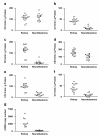Low aerobic mitochondrial energy metabolism in poorly- or undifferentiated neuroblastoma
- PMID: 20398431
- PMCID: PMC2861660
- DOI: 10.1186/1471-2407-10-149
Low aerobic mitochondrial energy metabolism in poorly- or undifferentiated neuroblastoma
Abstract
Background: Succinate dehydrogenase (SDH) has been associated with carcinogenesis in pheochromocytoma and paraganglioma. In the present study we investigated components of the oxidative phosphorylation system in human neuroblastoma tissue samples.
Methods: Spectrophotometric measurements, immunohistochemical analysis and Western blot analysis were used to characterize the aerobic mitochondrial energy metabolism in neuroblastomas (NB).
Results: Compared to mitochondrial citrate synthase, SDH activity was severely reduced in NB (n = 14) versus kidney tissue. However no pathogenic mutations could be identified in any of the four subunits of SDH. Furthermore, no genetic alterations could be identified in the two novel SDH assembly factors SDHAF1 and SDH5. Alterations in genes encoding nfs-1, frataxin and isd-11 that could lead to a diminished SDH activity have not been detected in NB.
Conclusion: Because downregulation of other complexes of the oxidative phosphorylation system was also observed, a more generalized reduction of mitochondrial respiration seems to be present in neuroblastoma in contrast to the single enzyme defect found in hereditary pheochromocytomas.
Figures



Similar articles
-
Mitochondrial function and content in pheochromocytoma/paraganglioma of succinate dehydrogenase mutation carriers.Endocr Relat Cancer. 2012 May 3;19(3):261-9. doi: 10.1530/ERC-11-0263. Print 2012 Jun. Endocr Relat Cancer. 2012. PMID: 22323561
-
Alterations of respiratory chain complexes in sporadic pheochromocytoma.Front Biosci (Elite Ed). 2011 Jan 1;3(1):194-200. doi: 10.2741/e233. Front Biosci (Elite Ed). 2011. PMID: 21196298
-
Comparative analysis of some aspects of mitochondrial metabolism in differentiated and undifferentiated neuroblastoma cells.J Bioenerg Biomembr. 2014 Feb;46(1):17-31. doi: 10.1007/s10863-013-9529-5. Epub 2013 Sep 27. J Bioenerg Biomembr. 2014. PMID: 24072403
-
Molecular pathogenesis of tumorigenesis caused by succinate dehydrogenase defect.Eur J Cell Biol. 2020 Jan;99(1):151057. doi: 10.1016/j.ejcb.2019.151057. Epub 2019 Nov 15. Eur J Cell Biol. 2020. PMID: 31810635 Review.
-
Clinical implications of the oncometabolite succinate in SDHx-mutation carriers.Clin Genet. 2020 Jan;97(1):39-53. doi: 10.1111/cge.13553. Epub 2019 May 6. Clin Genet. 2020. PMID: 30977114 Free PMC article. Review.
Cited by
-
Low VDAC1 Expression Is Associated with an Aggressive Phenotype and Reduced Overall Patient Survival in Cholangiocellular Carcinoma.Cells. 2019 Jun 4;8(6):539. doi: 10.3390/cells8060539. Cells. 2019. PMID: 31167495 Free PMC article.
-
Mitochondrial translation requires folate-dependent tRNA methylation.Nature. 2018 Feb 1;554(7690):128-132. doi: 10.1038/nature25460. Epub 2018 Jan 24. Nature. 2018. PMID: 29364879 Free PMC article.
-
A ketogenic diet supplemented with medium-chain triglycerides enhances the anti-tumor and anti-angiogenic efficacy of chemotherapy on neuroblastoma xenografts in a CD1-nu mouse model.Oncotarget. 2017 Aug 8;8(39):64728-64744. doi: 10.18632/oncotarget.20041. eCollection 2017 Sep 12. Oncotarget. 2017. PMID: 29029389 Free PMC article.
-
Catastrophic ATP loss underlies a metabolic combination therapy tailored for MYCN-amplified neuroblastoma.Proc Natl Acad Sci U S A. 2021 Mar 30;118(13):e2009620118. doi: 10.1073/pnas.2009620118. Proc Natl Acad Sci U S A. 2021. PMID: 33762304 Free PMC article.
-
Metabolic reprogramming related to whole-chromosome instability in models for Hürthle cell carcinoma.Sci Rep. 2020 Jun 12;10(1):9578. doi: 10.1038/s41598-020-66599-1. Sci Rep. 2020. PMID: 32533088 Free PMC article.
References
-
- Shimada H, Ambros IM, Dehner LP, Hata J, Joshi VV, Roald B, Stram DO, Gerbing RB, Lukens JN, Matthay KK, Castleberry RP. The International Neuroblastoma Pathology Classification (the Shimada system) Cancer. 1999;86:364–372. doi: 10.1002/(SICI)1097-0142(19990715)86:2<364::AID-CNCR21>3.0.CO;2-7. - DOI - PubMed
Publication types
MeSH terms
Substances
LinkOut - more resources
Full Text Sources
Medical

